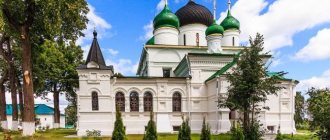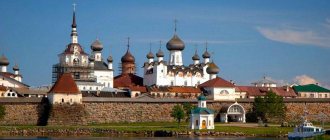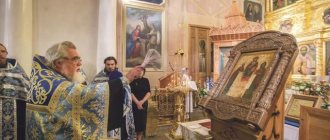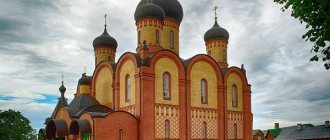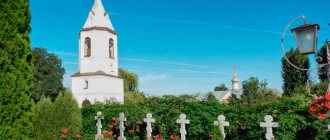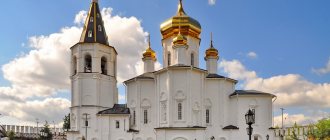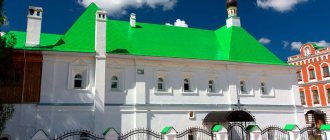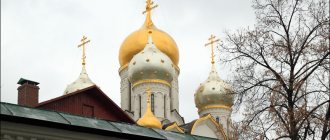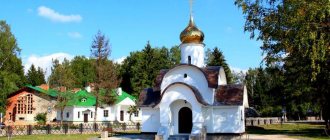Mother of God Nativity Monastery
It is located in Vladimir. The monastery was founded in 1191, by order of Grand Duke Vsevolod Yurievich. During the reign of Alexander Nevsky and more than 100 years after his death, it was one of the most influential monasteries in Rus'.
It was here that Alexander Nevsky was buried in 1263, and his relics were kept in this monastery until they were transported to St. Petersburg.
After 1917, this building housed the Cheka, and in 1930 they decided to demolish the monastery. In the same year, the cathedral and bell tower were destroyed, and pre-trial detention centers were built on this territory. Representatives of the clergy were kept in them, some of whom were sentenced to death.
All temple buildings were destroyed, with the exception of the Church of the Nativity. Since 1993, the revival of the monastery began: the preserved temple was reconstructed, and the construction of the cathedral began. Now it is a functioning monastery, which has its own shrines.
Gratitude from Ivan the Terrible
A new mention of the Spaso-Preobrazhensky Monastery dates back to the era of Ivan the Terrible. In 1552, the tsar made a third attempt to capture Kazan. Murom became the battle camp of the Grand Duke: military tents were pitched on the banks of the Oka, and rafts and plows were prepared here for the crossing. Praying for victory practically under the walls of the Spaso-Preobrazhensky Monastery, the tsar made a vow: in the event of the capture of Kazan, to build new churches in Murom.
Ivan the Terrible kept his word: soon after the campaign against Kazan, stone construction began in Murom, and soon the city was decorated with four new stone churches. At the same time, a new cathedral was built in the Spaso-Preobrazhensky Monastery. The Emperor did not forget the monastery throughout his reign, made considerable monetary contributions, donated church utensils, vestments, and books.
Pskov-Pechersky Monastery
This is one of the largest monasteries in Russia. He was located on the territory of Estonia. Because of this, it was able to survive during the difficult post-revolutionary period and never closed. But his parishioners were still discriminated against. The year of its foundation is considered to be 1473, when the cave church of the Assumption of the Mother of God was consecrated. The famous Archimandrite John (Krestyankin) once labored here.
It was about his stay within the walls of this monastery that the book “Unholy Saints” was written by Bishop Tikhon (Shevkunov), which became one of the most read among believers.
Church of Boris and Gleb in the village of Kideksha
An ancient architectural ensemble. The Falling Bell Tower, Stefanievskaya Church and the Church of Boris and Gleb. Kideksha village, Vladimir region, 1152. Photo: Sergey Lavrentyev / photobank “Lori”
The Boris and Gleb Church in the village of Kideksha not far from Suzdal appeared during the time of Yuri Dolgoruky, in 1152. This is one of the first white stone buildings in North-Eastern Rus'.
Building a church in those days was almost as difficult as the Egyptian pyramids. The material was mined near Moscow, 500 km from these places, and transported along rivers and land. Workers trimmed cobblestones and laid them with virtually no mortar.
The appearance of the church combined features of Russian medieval architecture and Western Romanesque style: a traditional cubic base, an unusually designed portal and arcature - rows of decorative false arches on the walls. Throughout history, the temple was restored more than once, and in the 17th century the dome was replaced.
At the end of the twentieth century, the Boris and Gleb Church was included in the UNESCO World Heritage List. Nowadays, the temple is not in use; frescoes from the 12th century are being studied here and excavations are taking place. Under the modern floor, researchers discovered the original base of the iconostasis and omphalia - a place for the bishop - made of rare pink stone. Omphalius of the Boris and Gleb Church is the oldest in Russia.
Read more about the Church of Boris and Gleb in the village of Kideksha.
Annunciation Monastery
This monastery has stood on the banks of the Oka River, in Nizhny Novgorod, since 1221. He had an unfortunate fate. In 1229, Prince Purgas ruined it, killing all the monks. Only 100 years later it was possible to revive it, but in 1369 the monastery was damaged by a snow collapse. Again many buildings collapsed and people died.
Metropolitan Alexy was able to revive it. He went to the Golden Horde and promised that if his visit ended well, he would rebuild it. The Metropolitan cured the Khan's wife, and he abandoned the raid. In 1370 he was able to fulfill his vow. Before the revolution, a copy of the Korsun Icon of the Mother of God was kept here, which was able to survive 3 fires. But then the monastery was closed, the list disappeared. Afterwards, a planetarium was located here. Its revival began in the 90s.
The most ancient monastery in Russia
All Orthodox Rus' this year was preparing for a great celebration, the 100th anniversary of the glorification of St. Seraphim of Sarov as a saint. Everyone was preparing: priests, monks, laity. We, professors and students of the State Academy of Slavic Culture, also prepared. Even 10 years ago, our Academy (rector - Professor I.K. Kuchmaeva) was the first in Russia to receive the blessing of His Holiness Patriarch Alexy II for the construction of a house university church, and this temple was built and consecrated in the name of St. Seraphim of Sarov. Could we stay away from the general celebration? With the blessing of His Holiness Patriarch Alexy II, we undertook a multi-day mission “The Path to Seraphim of Sarov.” The mission was headed by the rector of our home church, Archimandrite Jerome. Our path ran through many cities, temples and monasteries. Vladimir, Murom, Arzamas, Sanaksary, Diveevo, Ryazan passed before our eyes. Everywhere we met with the Orthodox intelligentsia, held round tables devoted to the most pressing issues of modern spiritual life in Russia, and tried to highlight the role of St. Seraphim in our life today. The beneficial impressions from the trip will remain in your memory for a long time. We also visited the oldest monastery in Russia, which is located in Murom. The territory of the Spaso-Preobrazhensky Monastery still resembles a construction site: the military unit recently handed over the monastery to the spiritual authorities. The barracks and other buildings are all in the process of being remodeled and adapted to the monastic needs. The restored Transfiguration Cathedral surprises with the abundance of ancient icons with unusual subjects. This place on the high bank of the Oka still remembers the holy martyr Prince Gleb! The exact date of the founding of the monastery is unknown, but it happened earlier than 1096 (that year the monastery was first mentioned in Russian chronicles)! First, Prince Gleb built a temple in the name of the Most Merciful Savior. In 1096, the son of Vladimir Monomakh, Prince Izyaslav, was buried in the monastery, who died in civil strife with the Murom prince Oleg (“Oleg went to the city, and Izyaslav was put in the monasteries of the Holy Savior”). The old (Glebovsky) church no longer exists - too many historical storms swept over the monastery land: at the beginning of the 17th century. it was plundered by the Poles and Lithuanians; during the reforms of Peter I, it lost most of its property. The current cathedral (temple in honor of the Transfiguration of the Lord) was built in 1553-1556. according to the vow of Ivan the Terrible, who stopped at the monastery on his way to Kazan. We are talking with the abbot of the Spaso-Preobrazhensky Murom Monastery, abbot Kirill (Epifanov), dean of the south-eastern district of the Vladimir diocese.
— Father, the monastery is about a thousand years old, it is impossible to tell about its entire history. I would like to know about the post-revolutionary fate of the monastery.
— The most important event that determined the history of the monastery was its closure in 1918. In general, the monastery was destroyed several times over its long history, starting with the Tatar-Mongol invasion. But no one could ruin like the Bolshevik yoke. The then rector, Bishop Mitrofan (Zvezdinsky), was repressed and the brethren were dispersed. The Bishop was accused of supporting the White Guard rebellion, although this was not the case: the Church was outside of politics, but supported the families of repressed or exterminated nobles and merchants. The monastery was one of the first to be liquidated in Russia, and until 1995 it was closed. But, undoubtedly, the Divine service continued mysteriously. All the temples have been preserved, although on the territory of the monastery there was first (in the 20s) a concentration camp, and from the beginning of the 1930s. - military unit.
— Is the history of the monastery being written?
— It is very difficult to collect information, since Murom was a closed city, and now it is almost impossible to find anything. In 1934, a communications regiment of special subordination to the General Staff of the USSR Armed Forces was stationed here. In 1995, we received a monastery in ruins, and the barracks, despite funding, were also in a dilapidated state. This is paradoxical - apparently, the Lord was preparing the military unit for eviction. In 1996, the monastery turned nine hundred years old. The first mention of it in the chronicle dates back to 1096. There it appears as the Monastery of the Savior on Bor in Murom.
— What are the main shrines of the monastery now?
— There were no holy relics in the monastery. Monasteries in the pre-Mongol era were founded by princes. Our monastery was founded by the holy noble prince Gleb, the son of the holy Equal-to-the-Apostles Prince Vladimir, the baptist of Rus', and the first Russian saint. Here, among the pagan Murom tribe, he built the first Christian temple of the All-Merciful Savior. This was the first Orthodox church in North-Eastern Rus'. On the site of his princely court (that is, the castle) this monastery was founded. Subsequently, this monastery became a missionary center. And the great shrine of our monastery today is the icon of the Mother of God “Quick to Hear.” It was brought from Holy Mount Athos by the rector of our monastery, Archimandrite Anthony (Ilyinov), in 1878. When he came to abbot this monastery, the monastery was in ruins, and he placed all his hope in the Mother of God. I myself went to Athos, brought this icon, and the image of the “Quick to Hear” immediately began to work miracles. And he still works miracles.
— Father Kirill, please tell us about at least a few such cases.
“The Mother of God appeared to the merchants and said: “Arrange me and I will arrange your affairs.” The merchants equipped the temple, restored it, made rich deposits - and the Mother of God helped them in their merchant affairs. And today the miracles from this icon are simply countless... Here are just a few examples. There was a case: a soldier disappeared in Chechnya. Parents come and ask how to pray for him: for health or for peace? We say: “Don’t pray as if you were dead, pray as if you were alive.” They order a magpie for the soldier’s health and pray. Then a message comes that his body has been identified; he died in battle. The Council of Veterans of Chechnya had already helped dig the grave, but at the moment when they were waiting for the galvanized coffin, he returned from captivity, alive and well. Another example. Recently a letter arrived from Siberia. In our monastery, people ordered prayers to the “Quick to Hear” icon of the Mother of God for the health of a man who had been paralyzed for three years and had not even spoken. We served prayer services and sent a small copy of our icon to Siberia. And here in the letter is a confession: as soon as the patient touched our icon, he was immediately healed, and his first words were: “Mama Maria.” We thank God and the Queen of Heaven for all these miracles that happen for the benefit of people. When we serve prayer services to the Mother of God, there are more people in the monastery than on great holidays. I don't know if this is good or bad, but it is true. People are crying, people are on their knees, people are receiving a response from the Queen of Heaven herself.
— How many brethren are there now in the most ancient monastery in Russia?
— There have never been many monks in our monastery, even before the revolution. It was an administrative center, its rector was always the Bishop of Murom. The monastery lived according to the Athos Charter. And then there were only ten monks in the state, and now there are the same number. But we have a very large missionary service, and we also involve parishioners in this work. In addition, we also have a special kind of inhabitants living in our House of Mercy. We have set aside a separate building for those people who are called homeless. There are especially many of them in winter. These are the people who come from prison, without documents, these are the people whom no one needs. Naturally, they don’t stay with us for long. We help them obtain passports and undergo primary social rehabilitation. We treat them for scabies, diagnose tuberculosis and other serious diseases. This is not an easy mission, but it is completely ours, a monastic one. We must not lose these people. We have a lot of pilgrims. We leave up to 60 people a day in the monastery for the night. And how many people come without an overnight stay! So every day people go to confession, to Communion - there is a lot of work.
“The grace of God is clearly palpable in the monastery...
- Yes, imagine - even in our ruins it feels like that. We have already consecrated three churches in the monastery, the main one of which is the Transfiguration Cathedral. There is also the Church of the Intercession of the Most Holy Theotokos, and in the rector’s building, above the refectory, the Church of St. Basil of Ryazan. It is interesting that just before our return to the monastery, eight years ago, there were cases where soldiers ran out of the barracks in horror, as there were apparitions of schema-monks who had already begun spiritually helping us in the matter of returning the monastery. A soldier comes into the quarters at night and sees a schema-monk standing with a cross. So the military authorities were simply forced to leave the monastery. After all, on this monastic land, the schematic prayer has been offered for a thousand (!) years. It's even hard to imagine. Holy, blessed land. Two Moscow Orthodox shrines also visited here in 1812: during Napoleon’s invasion, the miraculous icons of the Vladimir Mother of God (now in the Tretyakov Gallery) and the Iveron Mother of God were brought here. In our monastery, Saint Theophan the Recluse conducted a service in the rank of Bishop of Vladimir. The text of the sermon he delivered is still kept in the monastery. His Holiness Patriarch of Moscow and All Rus' Pimen was also here, but still in the rank of hieromonk, immediately after the SMERSH repressions. He served here for just over a year in 1945-1946. in the only functioning church in Murom.
— How is the monastery connected with the name of Tsar Ivan the Terrible?
— During his campaign against Kazan, Tsar John pitched his tent near the monastery. From this tent he watched the crossing of his troops across the Oka River. He prayed in the monastery and made a vow to God - if the campaign was successful, he would build a cathedral in the monastery. Spaso-Preobrazhensky Cathedral is the Cathedral of Ivan the Terrible.
— What are your principles for the spiritual structure of the monastery?
— The main principle is laid down in the Gospel. This is the principle of love.
In the pictures: Spaso-Preobrazhensky Monastery in Murom;
The abbot of the monastery is Abbot Kirill (Epifanov). Vladimir Melnik, Moscow 09/26/2003
Spaso-Preobrazhensky Solovetsky Monastery
It is located on the Solovetsky Islands, located in the White Sea. Since the 16th century, it served as a prison, which housed more than 500 people. After 1883, when the prison was closed, some church representatives who were guilty of something were still exiled to the monastery.
In 1920, the monastery was liquidated, and the Solovetsky prison appeared there, where the intelligentsia, White Army officers and clergy were imprisoned. In 1967, a museum-reserve appeared here, and in 2007 it was removed from the territory of the monastery.
Benedictine Abbey of Admont
Anyone who was lucky enough to visit the Austrian city of Admont, located on the Enns River, will never be able to forget the beautiful picture: the oldest monastery buildings from the Middle Ages, reflected in the water surface of the river.
The picturesque Admont owes its appearance to the Archbishop of Salzburg, who initiated its construction in 1704. Active educational work was carried out here; the monks were especially progressive in the natural sciences and in the description of historical facts. A modern school for girls was built near the monastery grounds, where the best of the monks taught.
The peak of prosperity came in the Middle Ages, during the ministry of Abbot Engelbert. He was a scientist ahead of his time, from whose pen many significant scientific works came out. It was at this time that a library began to function in the monastery, which to this day is the largest monastic library not only in Europe, but throughout the whole world. The collection of books is so magnificent that queues of visitors line up here every day. More than 70 thousand people visit the library every year. Here you can see 70 thousand handwritten texts and engravings, and among the 200 thousand books there are a huge number of the oldest copies created before the 13th century.
The hall where the library is located is a huge, bright room in which elements of neo-Gothic, Baroque and Romanesque styles are intricately mixed. In addition, there are museums of natural history and art history on site, and the exhibition hall often hosts music festivals. A special department exhibits paintings for the blind. One can only imagine how unique the exhibitions would have been if the monastery buildings had not been damaged by fire in 1865.
Some treasures of the oldest collection were sold during the crisis years of the 20th century, which became very difficult for the monks. There were years when the activities of the monastery were stopped by the National Socialist government, but from 1946 spiritual activities resumed and have not been suspended since then.
Deposition of the Robe Convent
This monastery is located in Suzdal, founded in 1207. He became famous thanks to Saint Euphrosyne. In the world, she was Princess Theodulia of Chernigov, who took monastic vows in this monastery and then became its abbess. She performed many miracles during her lifetime, as well as 2 posthumous miracles, which the monk Gregory wrote about.
In 1923, the monastery was closed, its bells were sent to be melted down, and political isolation ward guards were stationed in the buildings. Only in 1999 it was returned to the church and it was revived.
Kirillo-Belozersky Monastery
Its other name is the Kirillov Monastery. It is located near Lake Siverskoye in Kirillov. The monastery flourished in the 15th-17th centuries, when it was the largest and richest in Russia. Its charter was particularly strict. It was one of the Russian book centers.
It is believed that here the royal couple begged for an heir, who later became Ivan the Terrible. After the revolution, the monastery was destroyed, its abbot was shot. Everything was taken away, and the monastery library was also taken away. It could have been destroyed and demolished if a museum-reserve had not opened here in 1924. Until now, believers are trying to revive monastic life within its walls.
Saint Maurice
In Catholic culture, Saint Maurice is often referred to as the place where heaven is revealed to people. This is the oldest abbey in Western Europe, located in Italy, which survived the Middle Ages and has survived to this day. Over the past 15 centuries, spiritual life has not stopped here for a single day, and Divine services were held at regular intervals.
Saint-Maurice was founded in 515 on the site of the grave of St. Maurice, in whose honor the abbey received its name. The protection of the chosen saint was so strong that monastic life did not stop for a minute, and no disbandment or significant destruction occurred here. From mouth to mouth, many generations of monks since the Middle Ages have passed on the legend that during the next Divine service within the walls of one of the temples, Saint Martin appeared to those praying here, who is also the patron of this place, like Mauritius.
A local feature was that the ministers of the monastery were always jokers and people of subtle irony. You can verify this now when you come to Saint-Maurice. In many ways, this is what contributed to the fact that the monastery survived for many centuries, without becoming a victim of wars, changes in political forces and other vicissitudes. The monks believe that the reason for this is the favorable location: Saint-Maurice “hugs” against the rock, like a child clinging to its mother. The greatest danger, however, during the entire existence of the oldest monastery in Western Europe came precisely from this rock, from which fragments broke off seven times, destroying the church located under it. The last time this happened was in the middle of the 20th century, when a huge stone fell on the bell tower, leaving only ruins.
Many times Saint-Maurice was robbed by forest robbers and devastated by devastating fires. It happened that the monastery was flooded by mountain streams, but the monks steadfastly accepted all the troubles, without stopping their service. In 2015, the Great 1500th anniversary was celebrated here, organized with the participation of UNESCO.
Vvedenskaya Optina Pustyn
This one of the oldest monasteries is located near the city of Kozelsk. According to legend, it was founded by a repentant robber named Opta.
In 1821, a monastery appeared here, and hermits settled in it. People from all over Russia reached out to them, trying to get answers to their questions and healing. After the death of his son F.M. Dostoevsky stayed in the monastery for 3 days.
The monastery became famous for the Optina elders, who became the comforters of the people. After the revolution, Optina Pustyn was closed; it housed a rest home, a concentration camp, and a hospital. In 1987 it was returned to the church.
Monastery in Einsiedeln
There are several legends about the foundation of the monastery in Einsiedeln. But what these legends have in common is the fact that not far from the location of the current abbey, the hermit Mainrad settled in the forest, who had two faithful black ravens. One January day, two strangers asked to stay with the hermit for the night.
Having sheltered Mainrad, he fed them dinner, but they decided to rob him, and not finding anything valuable, they killed the hermit. While trying to escape, the killers were caught almost immediately thanks to black crows, which attracted local residents with their frantic screaming.
Over time, hermit monks began to come to the place of Mainrad’s death and thus a monastic community was formed. The creation of the monastery itself dates back to 934. From this time the Einsiedeln Abbey began its history of formation. For a thousand years, the monastery has become the main place of pilgrimage in Switzerland.
One of the first and main shrines of the abbey was the statue of the Black Madonna, allegedly consecrated by Jesus himself. But it burned to the ground in a fire that broke out in 1465.
It was replaced by another, which was donated by the abbess of Zurich, Hildegard, in 1466. Now the shrine is located in the temple building directly inside the “penitential chapel”. The monastery has a huge library room where the following are collected:
- 1230 ancient manuscripts;
- 740 incunabula;
- 700 paleotypes.
At the abbey there is a monastic school, and it also controls a Benedictine nunnery - Fahr Abbey near the city of Zurich, founded at the beginning of the 12th century.
St. George's Monastery
Near the Volkhov River, on the outskirts of Veliky Novgorod, the Yuriev Monastery is located. It was founded in 1030, once considered the spiritual center of the entire Novgorod land. After the October Revolution, all valuables were removed from the monastery, and after 1932 it became a home for the disabled. Later people lived here, a post office and other institutions were located. Only in the 90s did its revival begin.
Monastery of Mont Saint Michel
The oldest monasteries in Europe include Mont Saint-Michel, whose foundation was preceded by the appearance of the Archangel Michael to Bishop Aubert, who lived in the city of Avranches. Referring to a manuscript dating back to the 10th century, Aubert was ordered by the Archangel Michael to erect a temple on the island of Mont-Tomb (the current location of Mont-Saint-Michel).
Initially, several hermit monks settled on the island territory and built two small sanctuaries here . Archangel Michael appeared three times in Ober's dreams, since the bishop initially could not understand the will of the saint. Only the third time, when the Archangel pierced the bishop’s skull with his ring, did Oreb begin to build the temple.
The chapel built on the site of the current abbey was similar to the Monte Grotto sanctuary, located in southern Italy. It was from this grotto that some relics were brought to the chapel.
This is the crimson cover left by the Archangel, as well as part of the marble slab directly with the imprint of his foot. Over time, the influence of Mont Saint-Michel expanded throughout France, and the number of pilgrims wishing to visit the monastery increased accordingly. But the small territory of the temple did not allow receiving a large number of pilgrims, and on the basis of this, a decision was made to build a large building.
The problem arose that it was not possible to build a temple on the rock, but a way out was found. Initially, it was decided to build four chapels, which became a kind of platform for the further construction of the building. After their erection, construction of the temple began. It took almost 500 years (1023-1520)
The long life of the abbey has seen many adversities , for example, it was closed several times, punishment cells for prisoners were organized there, and it also had to survive religious wars. The monastery of Mont Saint-Michel remains a place of pilgrimage for parishioners from all over the world.
Valaam Spaso-Preobrazhensky Monastery
It is located on an island in Lake Ladoga, surrounded on all sides by water. It is considered one of the most beautiful monasteries. It is called Northern Athos. It was attacked and ravaged more than once, but the monks never took up arms or defended themselves, preferring to die.
The monastery flourished in the 19th century. After the revolution, he remained on the territory of Finland, thanks to which he was able to survive, but was subject to discrimination by the Finnish authorities. Until 1940, Valaam belonged to Finland, but then again went to Russia after the Russian-Finnish War. Now pilgrims flock to it, attracted not only by the history of the monastery, but also by the beautiful landscapes.
Montecassino
The monastery, created by Benedict of Nursia on the site of the former Temple of Apollo, is considered a landmark place not only for Italy, but also for the history of all medieval Europe. Its fate is full of bitter pages, as it was repeatedly destroyed. For this reason, only a small part of the oldest grandeur and beauty observed by the monks and pilgrims of the Middle Ages has been preserved here. Nevertheless, the flow of guests to this monastery, located 120 km from Rome, does not stop in any season.
After the construction of Montecassino in 529, the Benedictine Order arose on its territory. But after 33 years the buildings were destroyed by the Longobards. It took a century and a half to restore, but after another 170 years it was ravaged by the Saracens. Montecassino was rebuilt by Pope Agapit II, who understood its importance in the life of all of Italy. Military attacks also occurred during Napoleon's offensive in 1799.
The next and greatest destruction occurred during the Second World War in February 1944. Then a suspicion arose that there were high-ranking fascist military leaders on the territory of the monastery, so the territory was bombed. Only a few elements of the buildings were able to survive, but the main valuables of the collections, fortunately, managed to be evacuated before the bombing began, so they remained unharmed. During air attacks within the walls of Montecassino, hundreds of civilians who took refuge within these walls during wartime were killed.
On the personal instructions of the Pope, the Benedictine patrimony was restored in the seventies, after which thousands of pilgrims flocked here wanting to see the castle of the Middle Ages. Guests can admire the courtyard, temples, vineyards and listen to stories from medieval life.


